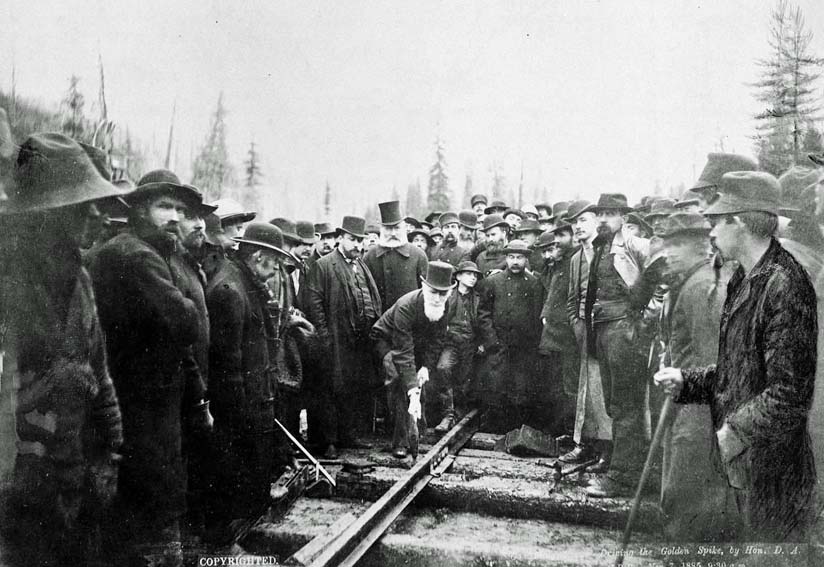
Canada - When a cluster of luminaries in top hats gathered in 1885 to hammer the very Last Spike on Canada's new coast-to-coast railway into the ground, the symbolism was obvious, The fledgling nation
of Canada was now one, from sea to shining sea.
on Canada's new coast-to-coast railway into the ground, the symbolism was obvious, The fledgling nation
of Canada was now one, from sea to shining sea.
 Coast to
coast a romantic notion but the railway only ran between Port Moody and Montreal. Although, technically, I guess you might say coast to coast if one considers
Montreal on the coast, but the track to the Atlantic coast at St. John came later.
Coast to
coast a romantic notion but the railway only ran between Port Moody and Montreal. Although, technically, I guess you might say coast to coast if one considers
Montreal on the coast, but the track to the Atlantic coast at St. John came later.
Almost a century and a half later, over 40,000 kilometres of steel track still knits the country together, and that's exactly why those looking to support
indigenous anti-pipeline protesters have seized upon the railway as the target of their disruptive actions this week.
The blockades reached a breaking point Thursday, with both VIA Rail and Canadian National shutting down major parts of their network.
Escalating protests across the country are in support of those fighting Coastal Gas Link's natural gas pipeline set to be built across Wet'suwet'en land in
northern B.C.
In response, those protesting in solidarity are striking at the rail network that knits the country together.
The targeting of the railway is no accident, protesters say.
Nikki Sanchez, a Pipil Maya Nation member who was part of the six day encampment at the B.C. legislature this week said there's "historic irony" to
the fact that railways were the infrastructure that was shut down as part of this movement.
"It's very historically significant because the project of colonization, as well as the extinction of the buffalo, was facilitated by the laying down of
the Trans-Canada railway," Sanchez said.
The railway was one of the first major projects undertaken by a new nation.
Canadian Pacific Railway was incorporated in 1881, and less than five years later, a rail line from coast to coast had been completed.
Tourists driving by the small outpost of Craigellachie in British Columbia can still pull over and visit the site where dignitaries pounded the "Last
Spike" into the ground with much fanfare.
 Fanfare?
Hardly.
Fanfare?
Hardly.
Canadian Pacific (CP) is still in operation, and its website declares that the railway "is considered to be one of Canada's greatest feats of
engineering."
Ivan Hall, a project manager of the Alberta Railway Museum, says that "the railway built western Canada, there's no question about it."
He points out that British Columbia refused to even join Confederation without a way to reliably cross the Rocky Mountains.
To this day, the railway is also an important shipping corridor for the landlocked middle of the country, "For the Prairies, it's our
lifeblood."
But for some, Canada's railways are a tangible example of the country's history of pushing into indigenous lands.
Emma Jackson, an organizer with Climate Justice Edmonton who says she's been watching the blockades closely, tweeted jokingly Wednesday that this may be the
only time she celebrates cancelled trains.
For her, targeting the railway means "shutting down the arteries of the settler state."
The railway was first built to "enable settlers to go and build their lives on indigenous lands," she said, adding that in that sense, rail lines are
a fair target when pushing back against pipelines and moving resources through indigenous land without consent.
While she points out that transit is important as Canada tries to lower carbon emissions, Thursday's announcement will see many train passengers stranded, it's
important to remember that for some, trains represent more than just an efficient ride.
"It's also probably the best tool that a lot of folks have at our disposal, in order to really put pressure on the decision-makers," she said, adding
that it's "mind-boggling" that politicians are focusing on the inconvenience that the blockades are creating.
"If you're going to talk about inconvenience, it is very inconvenient that you're going to be removed from your own land, forcefully at the barrel of a
gun," she said.
Sanchez, of the Pipil Maya Nation, said that since those rail lines run through Indigenous territories, the power to shut the service down should belong to
those First Nations.
It's not an activity those communities take lightly, though, and Sanchez said it wouldn't be possible if it weren't for the many non-indigenous Canadian allies
protesting for the Wet'suwet'en hereditary chiefs' cause.
"We have no interest in impacting individuals' livelihoods," Sanchez said, referring to the economic impact the CN shutdown is sure to
have.
 So the
protesters actions, which caused the laying off of perhaps as many as 6,000 rail workers, won't impact those individual's livelihood? Respect is a two-way
street.
So the
protesters actions, which caused the laying off of perhaps as many as 6,000 rail workers, won't impact those individual's livelihood? Respect is a two-way
street.
"We want a Canada that is upheld to justice."
Alex Boyd.
provisions in Section 29 of the Canadian
Copyright Modernization Act.
